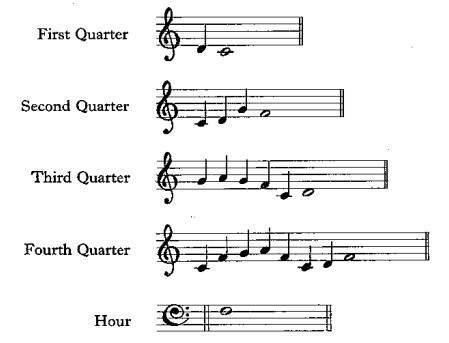Notes on the Gonville & Caius College chimes
- Posted in:
- college
Some information from two articles concerning the Gonville & Caius College chimes. Peter Tranchell included Wood's "It was an English Layde Bright" on the LP Music from Caius.
From The Caian, November 1972
The opportunity and challenge of composing a set of Bell chimes comes to composers comparatively rarely; so when, in 1910, an anonymous donor announced that he would present the College with a chiming clock, the then Organist and Director of Music, Dr. Charles Wood (1866—1926), to whom the problem of the musical aspects of the chimes had been referred, had some interesting problems to solve.
His thoughts on the matter are preserved in a sequence of rough notes (evidently intended as a basis for public utterance) scribbled on a sheet of manuscript paper and found by chance among his miscellaneous sketches at present deposited in the College library.
"In composing the chimes I had to bear in mind two important points
(1) that the amount of space available in the tower was very limited and
(2) how to get variety with the least amount of annoyance to others in College and in the neighbourhood.
"After a good deal of consideration I decided that the best series of notes for the purpose would be the following:

"This sequence of notes is in itself a melodious chime but unfortunately I had to reject it as it already exists in the. . . . . (unfinished sentence)"
In the event the chimes as finally evolved used the given sequence as follows:

Their melodic germ is to be found in a part-song for male voices* that Wood had published ten years previously:

but there is no evidence that there was any implied symbolism in the choice.
I. A. Copley.
* The opening phrase (Baritone solo) from "It was an English Layde Bright" (Albert Graem's song)—the words by Sir Walter Scott set as a part song for Baritone solo and male voice chorus (TTBB). London, Novello, 1900—the Orpheus Series of part songs (New Series) no. 334.
Additional note:
Though Dr. Copley considers no symbolism is intended, Mr. Tranchell suggests that the ballad ["It was an English ladye bright"] by Sir Walter Scott, with its tragic tale of internecine strife, has a striking feature for anyone who knows it:—the obsessive recurrence of a line (variously varied but basically) "But Love will still be Lord of all"; surely a pertinent reminder for a Collegiate Institution.
See also Biographical History, vol. VI pp. 511-513
From Gonville & Caius College Biographical History vol VI p 512 [part]
The five quarter bells of the chime, which was presented with the clock, have each round the upper rims the inscription: Ex dono Christopheri James A.M. Socii A.S. MCMXI; and each bell has its own inscription in hexameter form:
First Bell: Quinque notant horae partes : ego prima sororum.
Second Bell: Altera concentum soror addo pulsa priori.
Third Bell: Produco numeros ego tertia campanarurn.
Fourth Bell : Quarta tonos istis tribus effundo graviores.
Fifth Bell : Hora fugit: quinae clamamus voce quaterna.
The chime was composed by Charles Wood and was related to the "Wimbush" bell, which used to strike the hour.
